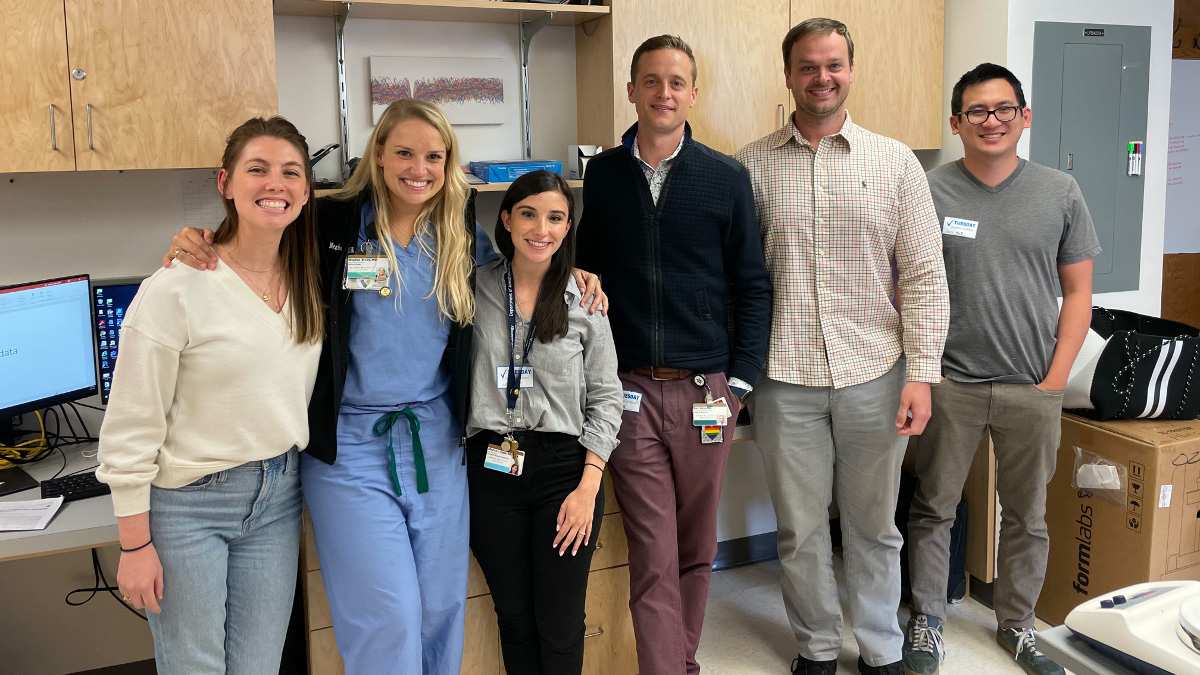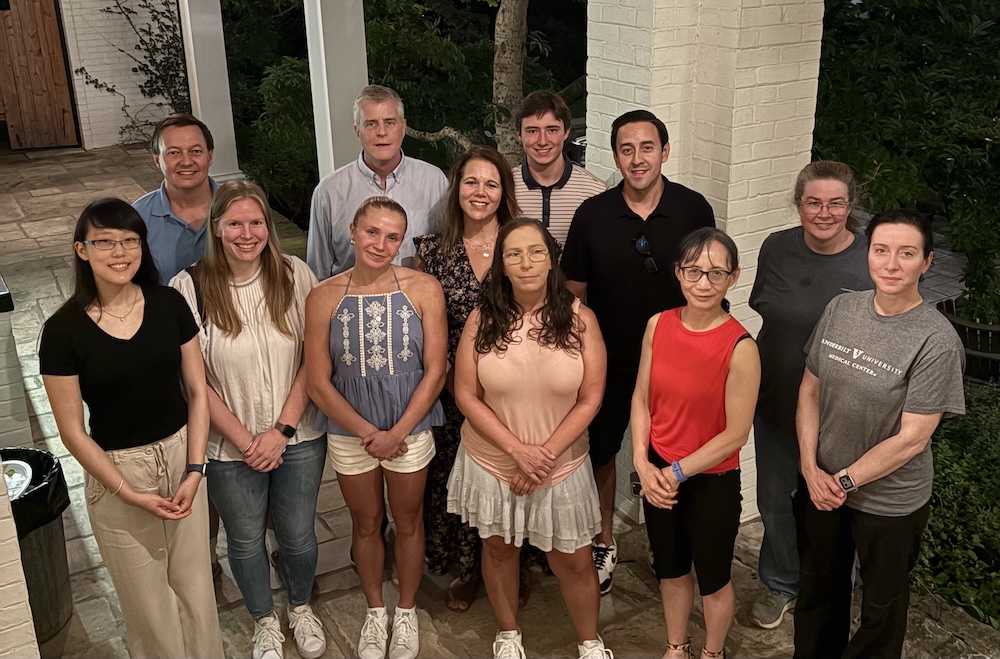The Department’s Translational Research Program focuses on improving patient care by advancing understanding of mechanisms driving perioperative, critical care and chronic pain morbidity. Investigators are performing laboratory and clinical studies to advance knowledge and develop interventions to decrease morbidity and improve recovery. Key focus areas include the study of acute brain injury, acute kidney injury, vascular biology, immune function and the transition from acute to chronic pain.
The Department’s Translational Research laboratories are supported by the National Institutes of Health, Veterans Administration and other extramural funding agencies. Investigators capitalize on Vanderbilt’s superb culture of interdepartmental collaboration. Anesthesiology investigators collaborate with researchers in the departments of surgery, medicine, pediatrics, obstetrics and gynecology, pathology and biostatistics to accomplish research goals.
-

The Alvis Laboratory in collaboration with the Vascular Waveform Analysis Group (VWAG) focuses on improving physiological monitoring through non-invasive venous waveform analysis (NIVA). This novel approach to monitoring has shown promise in assessing the volume state in both adults and children, as well as, shedding light on the respiratory condition in adults. Using a piezoelectric sensor on the volar aspect of a human wrist, venous waveforms are captured. Our research focuses on deconvoluting, processing, and analyzing these waveforms to investigate the patterns of the cardiac component, the respiratory component, and their respective harmonics to various volume and respiratory states. This involves human, porcine, and bench-top studies. Dr. Alvis’s lab not only conducts this translational research at VUMC, but they also support active NIVA research at multiple academic centers in the United States. Current studies include investigating venous waveforms during acute hemorrhage, sepsis, burns, atrial fibrillation, heart failure, pediatric resuscitation, pediatric hemorrhage, pediatric goal directed fluid therapy, acute respiratory distress, athletic dehydration, and acute volume overload.
Overall, the goal of the research in Dr. Alvis’s lab is to not only better understand the human volume state and respiratory condition, but to develop innovative, non-invasive technology that will bring better monitoring to patients and their clinicians.
-

Dr. Billings founded the Perioperative Organ Protection and Physiology Laboratory (PROTECT Lab) with long-term collaborator Marcos G. Lopez, MD, MS in 2021 to focus on developing new therapy for perioperative organ injury by conducting clinical trials and evaluating mechanisms of surgery-induced organ injury. Broadly this includes studying and manipulating the patient response to acute surgical stress to reduce morbidity, but specifically we are investigating the impact of perioperative oxidative damage as a mechanism of acute kidney and brain injury in patients having surgery. The PROTECT Lab conducts preclinical studies in mice, bench experiments with human tissues (arteries, arterioles, myocardium, fat, PBMCs, blood, urine), mechanistic, explanatory, and pragmatic clinical trials, and large-data epidemiologic studies to advance the R35-funded Research Program. The group collaborates with numerous experts and peer groups across the institution. Key collaborators include faculty in Division of Genetic Medicine Clinical Pharmacology, Department of Biostatistics, the Pragmatic Critical Care Research Group, the Division of Nephrology, and the Perioperative Clinical Research Institute.
To decipher mechanisms of perioperative organ injury and advance the care of patients having surgery, we conduct clinical trials of novel treatments and measure the impact of these treatments on candidate pathways (mechanisms) of injury, organ injury, and patient-centered outcomes.
For example, our 445 subject angiotensin converting enzyme inhibition or aldosterone antagonist randomized clinical trial to prevent acute postoperative atrial fibrillation demonstrated that intraoperative oxidative injury, as opposed to acute inflammation or anti-fibrinolysis, independently predicts postoperative acute kidney injury (AKI) and that perioperative statin use was associated with a decreased incidence of AKI. Based on those findings, we designed and completed the 653 Statin AKI Cardiac Surgery RCT, testing the hypotheses that short-term, high dose, perioperative atorvastatin reduces oxidative stress and AKI compared to placebo. We noted that isofurans – products of arachidonic acid peroxidation preferentially formed in conditions of relatively high oxygen tension – increased to a greater extent during surgery than F2-isoprostanes, the gold standard marker for quantifying oxidative injury in vivo. Tissue oxygen tension may be increased in vivo for two reasons, decreased consumption, as has been observed in patients with dysfunctional mitochondria, or increased delivery, as is typical among mechanically ventilated patients receiving supplemental oxygen in the operating room or ICU. We are exploring both possibilities.
To assess the effect of mitochondrial function on postoperative kidney, brain, and heart injury, we have measured mitochondrial DNA copy number, arterial lactate pyruvate ratios, and leukocyte PGC1alpha mRNA expression in patients undergoing cardiac surgery and have discovered that intraoperative mitochondrial dysfunction predicts postoperative AKI and delirium and that these markers of mitochondrial dysfunction are associated with increased concentrations of isofurans.
To assess the effect of excess oxygenation we designed and completed the Risks of Oxygen during Cardiac Surgery (ROCS) trial to test the hypothesis that physiologic oxygenation (normoxia) decreases the production of reactive oxygen species, oxidative damage, and organ injury compared to hyperoxygenation (hyperoxia). Indeed, normoxia decreased the intraoperative production of F2-isoprostanes and isofurans, but this effect did not persist in the postoperative period when normoxia and hyperoxia groups received similar oxygenation, and postoperative organ injury was similar between treatment groups. Both approaches were safe and there were some intriguing findings relative to neurologic injury and cardiac arrythmias that the group is not exploring.
To further measure the effect of different intraoperative oxygen administration strategies on patient outcomes, the Lab has initiated IntraOp Ox (supported by an IMPACT grant award from MPOG), a large multicenter cluster-randomized, cluster-crossover pragmatic multicenter clinical trial to test the hypothesis that a lower, intermediate, or higher oxygen administration strategy affects a composite of organ injury (kidney, brain, heart, and lung injury) and mortality.
Meanwhile, the group is also measuring the effect of various intraoperative and postoperative oxygenation strategies in mice during controlled renal and cerebral ischemia and reperfusion experiments.
Additional R01-supported projects include SOLSTICE (Lopez, PI), a clinical trial of preoperative vericiguat, a soluble guanylate cyclase stimulator, to attenuate perioperative vascular dysfunction and decrease markers of kidney and brain injury, KAOS-II (Billings, Co-PI, with Stephen Bruehl, PhD), an RCT of high dose Gly-NAC for 10 weeks in patients undergoing knee replacement to decrease oxidative damage and transition from acute to chronic pain, and MENDDS-II (Billings, site PI), an RCT of postoperative dexmedetomidine in extubated cardiac surgery patients to decrease delirium and cognitive dysfunction.
-
The work in Dr. Bruehl’s lab is focused on understanding acute and chronic pain and enhancing pain management. For more than 10 years, a key focus of the lab has been on understanding the physiological (endogenous pain inhibitory function) and psychosocial factors that influence the benefits versus risks experienced when individuals use opioid analgesics for pain management. The lab’s current work examines several hypothesized mechanisms that may contribute to known associations between elevated stress and risk for opioid misuse. Mechanisms being examined in this work include operant reinforcement (by subjective opioid effects), endogenous opioid function, endocannabinoids and vagal inhibition (indexed by heart rate variability). Dr. Bruehl’s lab has also previously conducted studies seeking to understand the mechanisms underlying beneficial effects of non-pharmacological interventions for chronic pain (aerobic exercise training, mindfulness, spinal manipulation therapy).
Another current focus of the Bruehl lab is on evaluating the role of oxidative stress as a contributor to adverse postsurgical pain outcomes. The lab is conducting an NIH-funded randomized clinical trial of a potent antioxidant intervention as a means of reducing the risk for adverse long-term pain outcomes following total knee arthroplasty surgery (TKA).
Several junior investigators (supported in part by NIH K-23 training grants) also conduct mentored pain research in Dr. Bruehl’s lab. Ongoing and planned studies address topics including:
- how parent and child psychosocial factors interact to influence parental decisions regarding use of opioid analgesics in their children following surgery,
- comparing analgesic and misuse-relevant subjective effects of oxycodone vs. buprenorphine with the goal of determining whether buprenorphine might have clinical utility in the post-surgical pain management setting but with lower misuse risk than typical opioids,
- understanding the extent to which mechanisms of chronic pain and autism may overlap and account for the apparent increased risk of chronic pain in autistic youth,
- genetic factors that may contribute to central sensitization to pain and opioid use patterns, and
- application of artificial intelligence to permit individualized pain management (precision pain medicine).
Dr. Bruehl’s work is conducted in both the laboratory and clinical settings and employs multiple methodologies. These include static (pain threshold, pain tolerance) and dynamic (temporal summation of pain, conditioned pain modulation) quantitative sensory testing, psychometric assessment, biological sampling (endocannabinoids, beta-endorphin, F2-isoprostanes, proinflammatory cytokines) and placebo-controlled administration of both opioid analgesics and opioid antagonists (the latter to evaluate endogenous opioid function).
Overall, the goal of the research in Dr. Bruehl’s lab is to better understand the biopsychosocial factors contributing to chronic pain and its related health risks, and ultimately, to improve treatment of chronic pain while mitigating against the risks associated with opioid analgesic use.
-
Dr. Susan Eagle is a Professor of Anesthesiology, Executive Vice Chair in the Department of Anesthesiology, and Executive Medical Director for Perioperative Services. She is a practicing adult and pediatric cardiothoracic anesthesiologist and is board certified in anesthesiology and transesophageal echocardiography.
The Eagle Lab has co-invented and developed several novel mHealth/wearable devices and algorithms for hemodynamic monitoring of cardiovascular and respiratory illness, including Peripheral Intravenous Waveform Analysis (PIVA) and Non-Invasive Venous Waveform Analysis (NIVA). She co-founded and served as both CMO and CEO of two startup companies to develop these devices and technology. An additional current focus is the use of novel echocardiographic technologies to detect left atrial appendage thrombus. The lab, in partnership with engineering researches, develops these technologies using controlled human studies, and clinical patients. Several of her mHealth devices have received national awards, including awards from the Southeastern Medical Device Association, the National Collegiate Inventors and Innovators Alliance, NEXT, and Google Entrepreneurs. Dr. Eagle has used her passion for faculty develop to mentor several Faculty members to develop independently funded research programs in device research and development.
Dr. Eagle has several patents around her technology and has licensed intellectual property to multinational medical device companies. She has successfully transitioned two of her novel medical devices from inception through Food and Drug Administration (FDA) clearance, via both de novo and 510(k) pathways. Dr. Eagle currently serves as Co-Principal Investigator on an NIH R01 (NHLBI) in conjunction with the School of Engineering for echocardiographic detection of left atrial appendage thrombus using artificial intelligence.
-
Dr. Stone’s lab is focused on understanding mechanisms which contribute to pediatric pain outcomes in order to improve pediatric pain interventions. As a pediatric psychologist, Dr. Stone approaches pediatric pain from a biopsychosocial perspective, with a specific focus on the dynamic relation between parent and child factors. Studies in the lab often take an intergenerational approach to understanding pain and related outcomes.
Click here to access the website for the Pain Research Group and learn more about Dr. Stone’s current work.